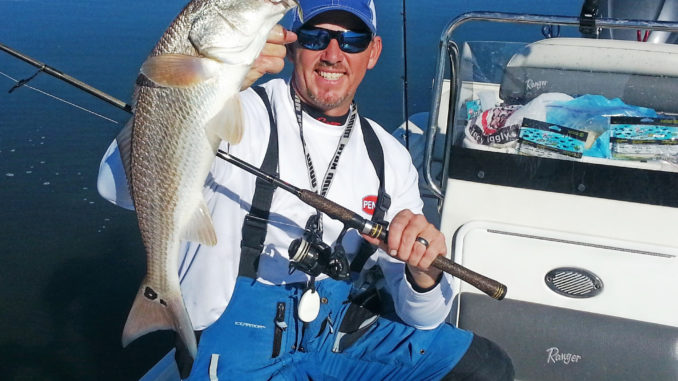
Huge schools patrolling Swansboro waters
The calendar flips to March about two months before saltwater fishing heats up for most inshore and nearshore species along North Carolina’s central coast, but guide Jeff Cronk of Swansboro’s FishN4Life Charters stays on top of a red drum bite that never seems to end and never seems to stop changing.
“By March, we’ll predominantly fish for red drum in the surf and backwaters,” said Cronk (336-558-5697). “Inside, we look for schools behind the beaches between the (Intracoastal Waterway) and the inlets. That includes up the rivers and feeder creeks off the rivers, like the White Oak, and creeks off the ICW, like Queens Creek.”
In March, redfish range throughout the 18- to 27-inch slot and above, but they’re not mixed, and Cronk finds them in different locations.
“It seems like most of the smaller, slot fish will be in the mainland creeks, while larger slot fish will be in the marsh systems where there’s higher-salinity water,” Cronk said.
During March, surf reds tend to range from 22 to 30 inches and longer. They swim inside and out of Bogue, Browns and Bear inlets depending on water temperatures and available baitfish.
“I think that is because we have three inlets 4 miles apart, and as water exchanges, fish move inside and out, too,” he said.
By March, almost all red drum that haven’t moved south will be in large marsh bays and creek systems behind the three inlets.
From November through December, ocean reds are in schools that may contain 2,000 and 3,000 fish, Cronk said. When they move behind the region’s barrier islands, they scatter but still may hold 250 to 1,000 fish per school.
“You have to fish for them with light tackle, because black winter algae coats the bottom,” he said. “I fish 4-inch Gulp shrimp and jerk shad weightless with weedless hooks. One of my favorite lures is a 4-inch Gulp split-tail, smelt-color minnow and a 1/16-ounce jighead I shave to 1/32-ounce.”
He uses 7- to 7 1/2-foot Penn spinning outfits spooled with 10- to 15-pound Spiderwire braid and 2 to 3 feet of fluorocarbon leader joined with a Uni knot.
“I can sling a 3- or 4-inch Gulp shrimp 40 to 50 yards with a 1/32-ounce jighead,” said Cronk, who finds redfish in shallow bays and creeks that have mud bottoms and warm considerably on sunny days.
“The backs of the established bays always have mullet minnows,” he said. “Reds may show up and stay a day or two or a month in one spot. Better bays are the ones with little creeks in the back that have deeper channels. Reds like to get in channels.”
But first he tries to spot redfish schools “pushing” surface water as they swim in bays, looking for food.
“It’s sight-fishing,” said Cronk, who stays a good distance from the fish and uses his trolling motor to get ahead of the reds. Then he’ll cast at the leading fish as the school approaches him.
“Sometimes you cast, let your lure sink and just twitch it once as they swim over it,” Cronk said. “But it’s crucial to have no wind and slick conditions to fish this way.”

